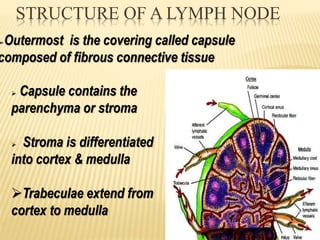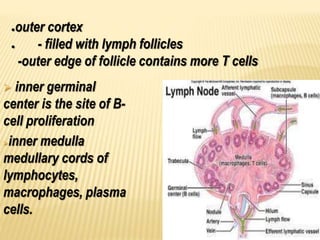Anatomy of lymph node by hussein ali hussein
- 1. ANATOMY OF LYMPH NODE PRESENTED BY HUSSEIN ALI HUSSEIN AL-HCHAIMI MSC. STUDENT ANESTHESIA DEPARTMENT TUMS
- 2. -- Oval, bean shaped structures scattered throughout body along lymph vessels. --Usually 1-25 mm in length, but they can be larger. ©CMay be deep or superficial. --Greatest concentration near groin, axilla, neck, thorax, and along gut tube in abdomen. In generally...
- 3. ? Distributed widely throughout the body including the armpit and stomach and linked by lymphatic vessels . ? Lymph nodes are major sites of B, T, and other immune cells . ? Large clusters in inguinal , axilliary , cervical regions.
- 8. STRUCTURE OF A LYMPH NODE ?Outermost is the covering called capsule composed of fibrous connective tissue ? Capsule contains the parenchyma or stroma ? Stroma is differentiated into cortex & medulla ?Trabeculae extend from cortex to medulla
- 10. Cortex Medulla ? inner germinal center is the site of B- cell proliferation ?inner medulla medullary cords of lymphocytes, macrophages, plasma cells. Ī±outer cortex Ī± - filled with lymph follicles -outer edge of follicle contains more T cells
- 11. CYTOLOGY OF THE LYMPH NODE The normal or reactive lymph node is composed of ? Transient B and T lymphocytes ? Antigen processing and presenting cells ? Replicating B and T lymphocytes (in response to antigen) ? Persistent and transient final effector cells ? Macrophages
- 12. ? B lymphocytes are located primarily in the follicles and perifollicular areas ? T lymphocytes are found primarily in the interfollicular or paracortical areas of the lymph node.
- 13. ?Macrophages and lymphocytes reside in the outer ("cortex") region of a node. Ī±Afferent (entering) vessels bring lymph in. Ī±Lymph first enters into a large subcapsular sinus & then into many small sinuses. Ī±Throughout the node are lymph sinuses crisscrossed by reticular fibers
- 14. ?The node acts as a Ī░settling tank,Ī▒ because there are fewer efferent vessels, lymph stagnates somewhat in the node. ?Macrophages reside on these fibers where they phagocytise foreign matter.
- 15. ?This allows lymphocytes and macrophages time to carry out their protective functions ?Reticular fibers filter and trap damaged cells, microorganisms, foreign substances, tumor cells. ? Macrophages phagocytize some, lymphocytes destroy some by immune defenses. "Medulla" is the inner collecting area. Efferent (exiting) vessel leaves at the "hilus.
- 17. DISTRIBU TION
- 18. Lymph nodes of clinical importance have been put under 5 main groups : ? Cervical groups ? Axillary groups ? Inguinal groups : >Iliac ? Trachiobronchial ? Aortic
- 20. CERVICAL GROUPS ?Right & left groups each divided into: horizontal (circular) and vertical ? The horizontal group include: ? sub-mental ? sub-mandibular ? parotid ? pre-auricular ? post-auricular ? occipital
- 21. CONTĪŁ ? The vertical group include: ? superficial (along external jugular vein) ? deep (along internal jugular vein) ? Pre-laryngeal ? Pre-tracheal ? Para-tracheal
- 22. AXILLARY GROUPS ? Right & left groups ? each divided into 5 groups: ? Anterior (pectoral) ? posterior (sub-scapular) ? medial (along chest wall) ? lateral ? central
- 24. ? Horizontal group lies along the inguinal ligament (both above and over) ? Vertical group is beside the great saphenous vein in the proximal thigh. ? Iliac nodes : above and deep to inguinal ligament Inguinal groups
- 26. ? The human body has two small groups which are : ? Epitrochlear lymph nodes . ? Popliteal lymph nodes : these nodes are located posterior to the knee joint .
- 27. 3 cm proximal to the medial humeral epicondyle, in the groove between the biceps and triceps brachii. Epitrochlear nodes
- 28. LYMPH NODES FUNCTION ? Help protect the body by removing foreign material (bacteria and tumor cells). ? Protect the body by producing lymphocytes. ? Filter lymph fluid to trap foreign
- 29. THANK YOU.....




























